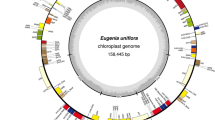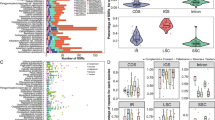Abstract
The nucleotide composition and the contents of CpG and CpNpG in internal transcribed spacers 1 and 2 (ITS1 and ITS2) and the 5.8S rRNA gene of the nuclear genome were studied in two phylogenetic lineages of monocotyledonous angiosperms. The evolutionary advance of taxa by morphological characters proved to positively correlate with an increase in the contents of C, CpG, and CpNpG, contrasting the views that genome evolution in vertebrate and higher plants tends to decrease or, at least, preserve the amount of CpG and CpNpG, potentially subject to methylation, in nuclear DNA. Cryptaffinity taxa, which are intermediates between morphologically distinct taxonomic groups, displayed higher contents of CpG and CpNpG as compared with neighboring taxa. Changes in the contents of these elements in the regions of cryptaffinity taxa are intricate, suggesting a reciprocating character for their accumulation. Cryptaffinity taxa and their close phylogenetic relatives from the ancestral and descendant groups were assumed to reflect the key macroevolutionary changes and to correspond to saltatory periods separating the periods of gradual evolution.
Similar content being viewed by others
References
Chupov V.S. 2001. On probable functional differentiation of genomes during phylogeny and approaches to its study: 1. Neontological annals of evolution and their analysis. Tsitologiya. 43, 975–986.
Chupov V.S. 2002. On the course of development of phylogenetic side branch. Tsitologiya. 44, 323–333.
Chupov V.S. 2001. On probable functional differentiation of genomes during phylogeny and approaches to its study: 2. Possible approaches to elucidating the material basis of inequality of phylogenetic lineages. Tsitologiya, 43, 987–991.
Chupov V.S., Punina E.O., Machs E.M., Rodionov A.V. 2003. Saturation of ribosome cluster components with CpG elements. Materialy s”ezda VGO im. N.I. Vavilova (Proc. Conf. Vavilov All-Russia Geneic Society). 2, 223–224.
Chupov V.S., Punina E.O., Machs E.M., Rodionov A.V. 2003. CpG and CpNpG elements of ribosome cluster in monocotyledon taxa differing in the level of evolutionary development. In: Botanicheskie issledovaniya v Aziatskoi Rossii (Botanical Studies in Asian Russia), vol. 2.
Chupov V.S., Punina E.O., Machs E.M., Rodionov A.V. 2004. Specificity of the mutation process in taxa of the transitional zone between families Melanthiaceae and Trilliaceae. In: Genetika in XXI veke: sovremennoe sostoyanie i perspektivy razvitiya (Genetics in the 20st Century: Current State and Prospects), Moscow: Nauka, vol. 2.
Sumner A.T. 1990. Chromosome Banding. London: Nyman.
Singer M., Berg P. 1991. Genes and Genomes. Mill Valley, CA: University Science Books, 1991.
Chupov V.S. 2002. Form of phylogenetic side branch in plants according to data on neontological-taxonomic annals of evolution. Usp. Sovrem. Biol. 122, 227–238.
Chargaff E. 1950. Chemical specificity of nucleic acids and mechanism of their enzymatic degradation. Experientia. 6, 201–209.
Chargaff E. 1951. Structure and function of nucleic acids as cell constituents. Federat. Proc. 10, 654–659.
Belizersky A.N., Antonov A.S., Mednikov B.M. 1972. Introduction, In: Stroenie DNK i polozhenie organizmov v sisteme (DNA Structure and Positions of Organisms in the System). Eds. Belozersky A.N., Antonov A.S. Moscow: Mosk. Gos. Univ., pp. 3–16.
Bird A. 1980. DNA methylation and frequency of CpG in animal DNA. Nucleic Acids Res. 8, 1499–1504.
Bird A. 2002. DNA methylation patterns and epigenetic memory. Genes Dev. 16, 6–21.
Mazin A.L., Vanyushin B.F. 1987a. Loss of CpG dinucleotides from DNA: 1. Methylated and nonmethylated genome compartments in eukaryotes with different 5-methylcytosine in DNA. Mol. Biol. 21, 543–551.
Finnegan E., Kovac K. 2000. Cytosine deamination plays a primary role in the evolution of mammalian isochors. Plant. Mol. Evol. 43, 189–201.
Mazin A.L., Vanyushin B.F. 1987b. Loss of CpG dinucleotides from DNA: 2. Methylated and nonmethylated genes of vertebrates. Mol. Biol. 21, 552–561.
Boudraa M., Perrin P. 1987. CpG and TpA frequencies in the plant system. Nucleic Acids Res. 15, 5729–5737.
Rodionov V.A., Tyupa N.B., Kim E.S., Machs E.N., Loskutov I.G. 2005. Genomic constitution of autotetraploid oat, Avena macrostahia, revealed by comparative analysis of ITS1 e ITS2 sequences: On evolution of cultivated and wild oat caryotypes at early stages of Avena species divergence. Genetika. 41, 1–9.
Melchior H. 1964. Engler’s Syllabus der Pflanzenfamilien. Berlin-Nikolassee: Borntrager, vol., issue 12.
Hutchinson J. 1973. The Families of Flowering Plants, 3rd ed. Oxford: Clarendon.
Thorne R. 1992. Classification and geography of the flowering plants. Bot. Rev. 58, 1–348.
Chupov V.S. 1994. Phylogeny and system of orders Liliales and Asparagales. Bot. J. 79, 1–12.
Takhtajan A. 1996. Diversity and Classification of Flowering Plants. N.Y.: Columbia University Press.
APG. 1998. An ordinal classification for the families of flowering plants. Ann. Missouri Bot. Garden. 85, 531–553.
APG. 2003. The angiosperm phylogeny group classification for the orders and families of flowering plants APG II. Bot. J. Linn. Soc. 141, 399–436.
Chase M.W., Soltis D., Soltis P., Rudall P., Fay M., Hahn W., Sullivan S., Jeffrey J., Molvray M., Kores P., Pires C., Olmstead R.G., Morgan D., Les D.H., Mischler B.D., Duvall M.R., Price R.A. 2000. Higher-level systematics of the monocotyledons. In: Monocots: Sysematics and Evolution. Eds. Wilson K., Morrison D. Melbourne: CSIRO.
Zomlefer B., Whitten M., Williams H., Judd W. 2003. An overview of Veratrum s. l. and an infrageneric phylogeny based on ITS sequence data. Syst. Bot. 28, 250–269.
Chupov V.S., Kudryakova N.V. 1996. Electrophoretic mobility of esterases from seeds of Liliaceae plants as an index characterizing the level of their evolutionary development. Bot. Zh. 81, 47–54.
Patrushev L.I. 2000. Ekspressiya genov (Gene Expression). Moscow: Nauka.
Gromova E.S., Khoroshaev A.E. 2003. Prokaryotic DNA methyltransferases: Structure and mechanism of interaction with DNA. Mol. Biol. 37, 300–314.
King K., Torres R., Zentgraf U. Hemleben V. 1993. Molecular evolution of the intergenic spacer in the nuclear ribosomal RNA genes of Cucurbitaceae. J. Mol. Evol. 36, 144–152.
Matsuo K., Clay O., Takahashi T., Silke J., Schaffner W. 1993. Evidence for erosion of mouse CpG islands during mammalian evolution. Somat. Cell Mol. Genet. 19, 543–555.
Moor G., Abbo S., Cheung W., Foote T., Gale M., Koebner R., Leitch A., Leitch I. 1993. Key features of cereal genome organization as revealed by the use of cytosine methylation-sensitive restriction endonucleases. Genomics. 15, 472–482.
Jansson S., Meyer-Gauen G., Cerff R., Martin W. 1994. Nucleotide distribution in gymnosperm nuclear sequences suggests a model for GC-content change in land-plant nuclear genomes. J. Mol. Evol. 39, 34–46.
Clay O., Schaffner W. Matsuo K. 1995. Periodicity of eight nucleotides in purine distribution around human genomic CpG dinucleotides. Somat. Cell. Mol. Genet. 21, 91–98.
Berkhout B., Grigoriev A., Bakker M., Lukashov V.V. 2002. Codon and amino acid usage in retroviral genomes is consistent with virus-specific nucleotide genomes. AIDS Res. Hum. Retrovir. 18, 133–141.
Tajama S., Suetake I. 1998. Regulation and function of DNA methylation in vertebrats. J. Biochem. (Tokyo). 123, 993–999.
Bird A. 1987. CpG islands as gene markers in the vertebrate nucleus. Trends Genet. 3, 342–347.
Gardiner-Garden M., Frommer M. 1987. CpG islands in vertebrate genomes. J. Mol. Biol. 196, 261–282.
Gardiner-Garden M., Sved M., Frommer M. 1992. Methylation sites in angiosperm genes. J. Mol. Evol. 34, 219–230.
Kawasaki K., Minoshima S., Kudoh J., Shimizu N. 1992. Methylation status of ribosomal RNA gene clusters in the flow-sorted human acrocentric chromosomes. Mamm. Genome. 3, 173–178.
Sardana R., O’Dell M., Flavell R. 1993. Correlation between the size of the intergenic regulatory region, the status of cytosine methylation of rRNA genes and nucleolar expression in wheat. Mol. Gen. Genet. 236, 155–162.
Torres-Ruiz R., Hemleben V. 1994. Pattern and degree of methylation in ribosomal RNA genes of Cucurbita pepo L. Plant Mol. Biol. 26, 1167–1179.
Hendrich B., Tweedie S. 2003. The methyl-CpG-binding domain and the evolving role of DNA methylation in animals. Trends Genet. 19, 269–277.
Kovarik A., Matyasek R., Leitch A., Gazdova B., Fulnecek J., Bezdek M. 1997. Variability in CpNpG methylation in higher plant genomes. Gene. 204, 25–33.
Cardon L., Burge C., Claiton D., Karlin S. 1994. Pervasive CpG suppression in animal mitochondrial genomes. Proc. Natl. Acad. Sci. USA. 91, 3799–3803.
Buckler E. IV, Holtsford T. Zea ribosomal repeat evolution and substitution patterns. Mol. Biol. Evol. 13, 623–632.
Mazin A.L. 1995. Factor IX gene methylation is the main cause of mutations resulting in hemophilia B. Mol. Biol. 29, 71–89.
Chupov V.S., Machs E.M. 2006. Variation in nucleotide composition of the region ITS1-5.8S rRNA-ITS2 in evolutionary advanced and evolutionary static branches of the monocotyledonous plants. Proc. 5th Int. Conf. Bioinformatics of Genome Regulation and Structure. Novosibirsk, Russia, July 16–22, 2006. Novosibirsk, vol. 3 pp. 133–137.
Karlin S., Mrasek J. 1997. Compositional differences within and between eukaryotic genomes. Proc. Natl. Acad. Sci. USA. 94, 10,227–10,232.
Krutyakov V.M. 2006. Eukaryotic error-prone DNA polymerases: Presumed roles in replication, repair, and mutagenesis. Mol. Biol. 40, 3–11.
Zomlefer W., Williams N., Whitten M., Judd W. 2001. Generic circumscription and relationships tribe Melanthieae (Liliales, Melanthiaceae) with emphasis on Zigadenus: Evidence from ITS and trnL sequence data. Am. J. Bot. 88, 1657–1669.
Fuse F., Tamura M.A. 2000. Phylogenetic analysis of the plastid matK gene with emphasis on Melanthiaceae sensu lato. Plant Biol. 2, 415–427.
Chupov V.S. 1990. Notes on phylogenetic relationships of some groups of monocotyledons. Bot. Zh., 75, 1092–1102.
Rydberg P. 1903. Some generic segregations. Torr. Bot. Club. 30, 271–281.
Bogler D., Neff J., Simpson B. 1995. Multiple origins of the yucca-yucca moth association. Proc. Natl. Acad. Sci. USA. 92, 6864–6867.
Fay M., Chase M. 1996. Resurrection of Themidaceae for the Brodiaeae alliance and recircumscription of Alliaceae, Amaryllidaceae and Agapanthoideae. Proc. Natl. Acad. Sci. USA. 45, 441–451.
Pfosser M., Speta F. 1999. Phylogenetics of Hyacinthaceae based on plastid DNA sequences. Ann. Missouri Bot. Gard. 86, 852–875.
Tkhtajan A.L. 1964. Osnovy evolyutsionnoi morfologii pokrytosemyannykh (Fundamentals of Evolutionary Morphology of Angiosperms). Moscow: Nauka.
Takhtajan A.L. 1996. Sistema i fologeniya tsvetkovykh rastenii (The System and Phylogeny of Flowering Plants). Moscow: Nauka.
Cronquist A. 1981. An Integrated System of Classification of Flowering Plants. N.Y.: Columbia Univ. Press.
Mazin A.L. 1993. Genome loses the whole amount of 5-methylcytosine during lifetime: How it is related to accumulation of mutations during aging. Mol. Biol. 27, 160–173.
Author information
Authors and Affiliations
Corresponding author
Additional information
Original Russian Text © V.S. Chupov, E.O. Punina, E.M. Machs, A.V. Rodionov, 2007, published in Molekulyarnaya Biologiya, 2007, Vol. 41, No. 5, pp. 808–829.
Rights and permissions
About this article
Cite this article
Chupov, V.S., Punina, E.O., Machs, E.M. et al. Nucleotide composition and CpG and CpNpG content of ITS1, ITS2, and the 5.8S rRNA in representatives of the phylogenetic branches melanthiales-liliales and melanthiales-asparagales (Angiospermae, Monocotyledones) reflect the specifics of their evolution. Mol Biol 41, 737–755 (2007). https://doi.org/10.1134/S002689330705007X
Received:
Accepted:
Issue Date:
DOI: https://doi.org/10.1134/S002689330705007X




